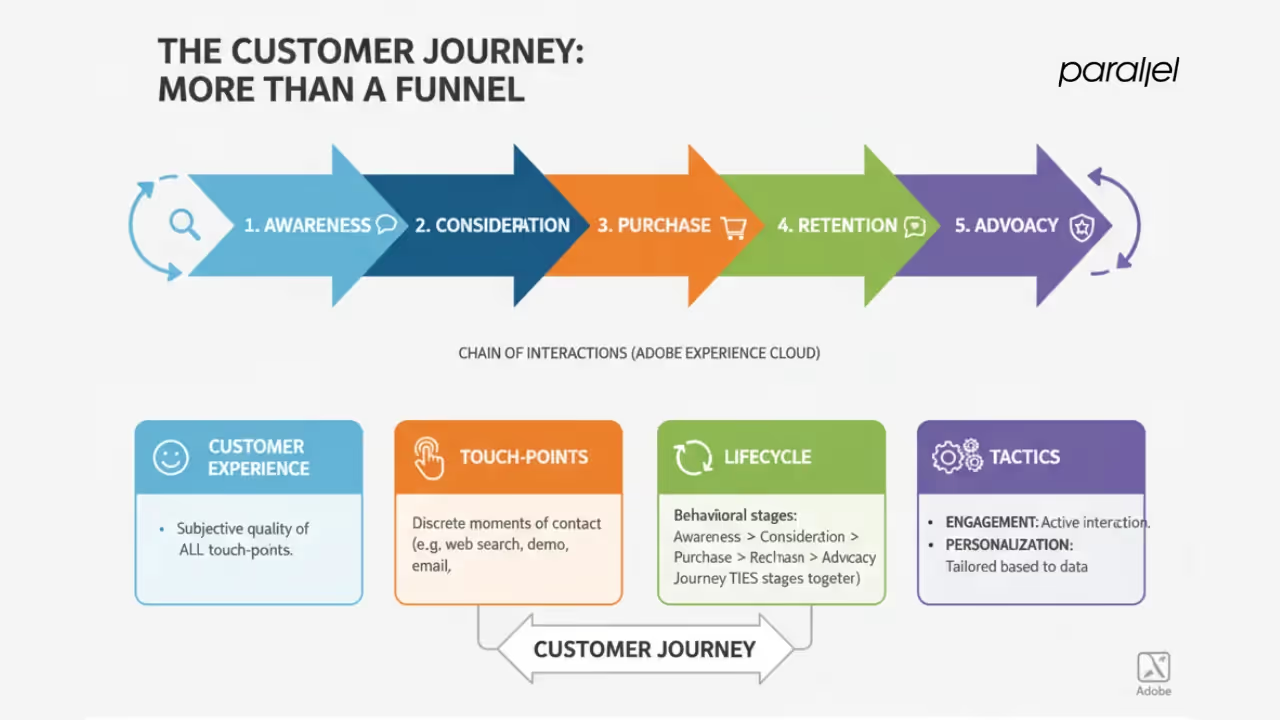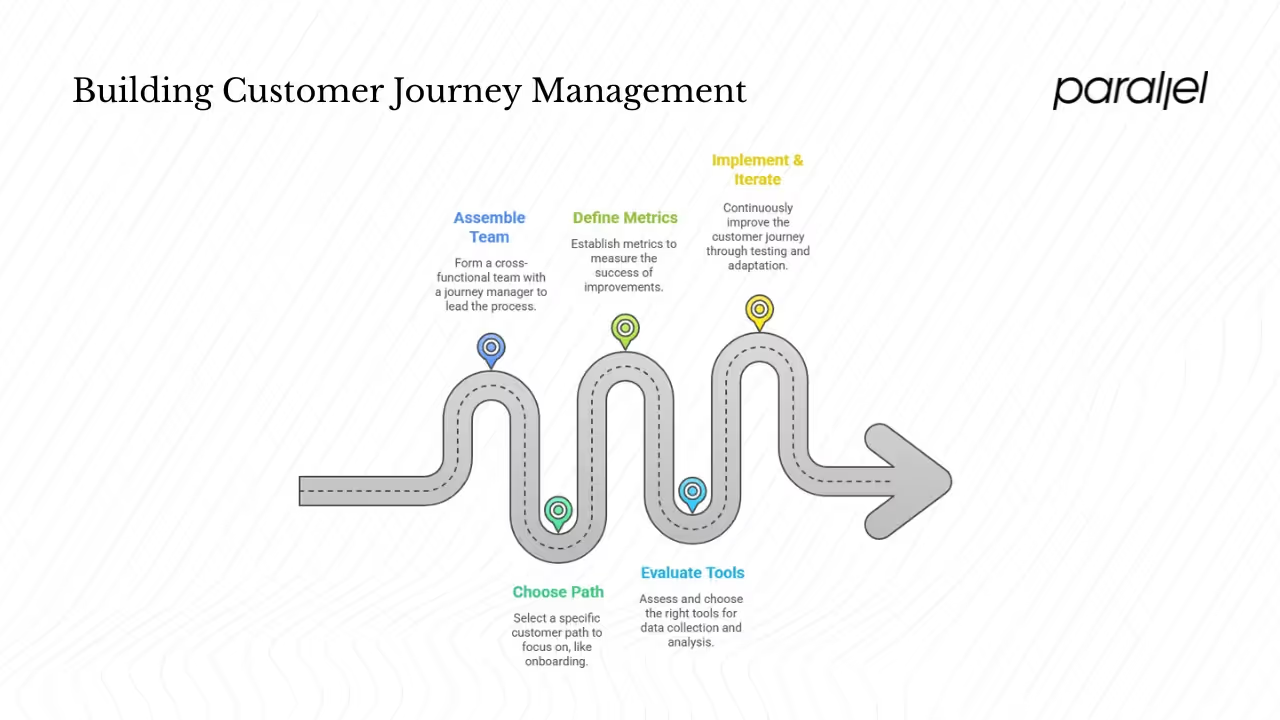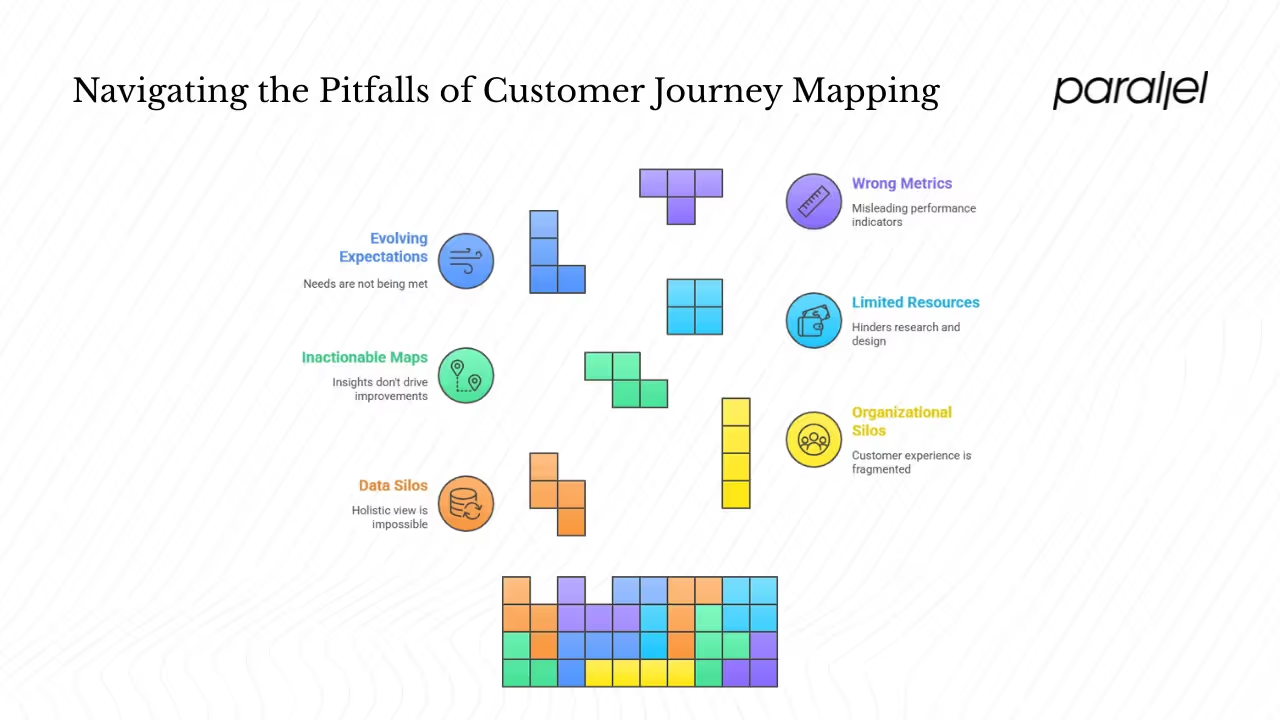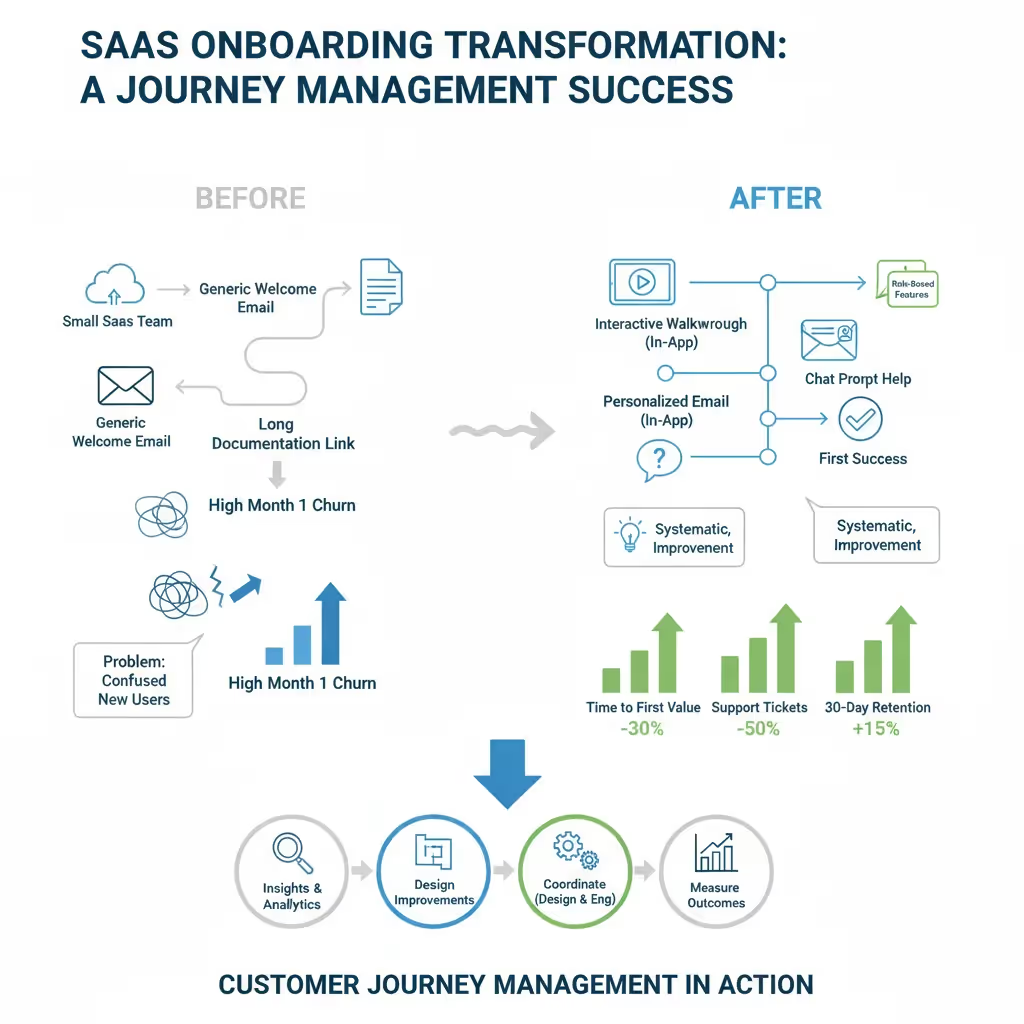What Is Customer Journey Management? Guide (2025)
Explore customer journey management, how mapping touchpoints improves experiences, and tools to orchestrate personalized interactions.

As a founder at Parallel, I’ve had a front‑row seat to how early‑stage teams hit a wall. You get traction, but growth stalls and churn climbs. Customers don’t stick around just because you built a great product. They stick around when every interaction meets a need, answers a question, or sparks trust. That’s why understanding and managing the entire customer path becomes a strategic tool for young companies. This guide explains what customer journey management is, why it matters, and how to build a practice around it.
What’s the customer path and how is it different from other ideas?
When people talk about the “customer journey” they’re referring to the chain of interactions a person has with a company. According to Adobe’s Experience Cloud team, a customer’s path starts with awareness, continues through purchase, and extends into loyalty. This path goes farther than a typical buyer’s journey because it includes support and advocacy. Understanding it forces you to see the world from the customer’s perspective — not just as a funnel in a slide deck.
It’s easy to confuse this concept with a few neighbouring ideas:
- Customer experience refers to how people feel about every touch‑point they have with your company. It’s the subjective quality of interactions, from your website to support chats.
- Touch‑points are the discrete moments of contact: a web search result, a product demo, an invoice email. Each touch‑point is part of the larger path but doesn’t tell the whole story.
- Lifecycle describes stages of customer engagement. In Adobe’s framework these are awareness, consideration, purchase, retention and advocacy. Lifecycle focuses on behavioural stages; the customer journey ties those stages together and considers the flow between them.
- Engagement and personalization are tactics. Engagement looks at how actively a customer interacts with your product or brand. Personalization tailors those interactions based on user data. Both fit within a larger journey management approach.

So what is customer journey management? Service Management Group (SMG) defines it as the process of understanding the stages of the customer path, identifying touch‑points and optimizing those moments to improve the overall experience. Genesys adds that it is a strategic, data‑driven practice of visualizing, optimizing and getting the entire organization to act around customers’ needs. It’s not just mapping interactions; it’s an ongoing discipline that draws on research, design and cross‑functional coordination to help teams respond quickly to changing expectations.
Mapping alone has limits. Deloitte’s designers point out that static maps become outdated as soon as the business evolves. Without a management practice, mapping leads to fragmentation, inconsistent implementation across teams and a lack of clear next steps. Journey management solves those issues by moving from static visuals to real‑time strategies and data‑driven action. That’s why this guide uses the phrase customer journey management nine times: to keep focus on a complete approach, not just a diagram.
Why should early-stage teams care about customer journey management?
At a start‑up, every user matters. Your runway is tight and switching costs are low. You need people to come in, get value quickly, stay and tell others. A customer‑centric approach helps you do that because people now base their buying decisions on the total experience, not just features.
Recent statistics tell the story. By 2025, 89% of businesses expect to compete primarily on customer experience. Eighty percent of customers value their experience with a company as much as its products. Personalization drives 40% higher revenue for companies that excel at it. Sixty‑five percent of consumers expect personalized experiences, and 80% are more likely to buy from brands that deliver them. Omnichannel consistency matters too: purchase and engagement rates are 250% higher when people interact across multiple channels and retention can improve by 90%.
On the flip side, ignoring the customer path comes with real costs. Adobe points out that 29.6% of customers refuse to use web‑based channels after a poor experience. The OnRamp report notes that a financial services case study reduced customer defections by 16% after prioritizing experience improvements. And Genesys reminds us that focusing on isolated interactions rather than the entire path creates silos and friction. In short, managing the whole customer path isn’t a luxury — it’s a survival skill.
What are the core elements of a customer journey management practice?
1) Insights and research
You can’t improve what you don’t understand. A solid practice starts with data: qualitative and quantitative. Techniques include:
- Customer interviews and surveys to learn about goals, pain points and emotions. SMG notes that many customers begin their path by researching products and services on search engines, social media and review sites. Talking to people helps you find out what they’re doing in those moments.
- Analytics and usage data from your product, marketing site, or support channels. Genesys emphasizes the need to map both web‑based and offline interactions — from chatbot engagements to in‑person calls — to get a full picture.
- Voice‑of‑customer feedback pulled from reviews, support tickets and surveys. Analyzing feedback can reveal recurring issues like slow response times.
Gathering these inputs is just the start. You need to synthesize them into a narrative about how people move through the stages and where friction occurs. This is where mapping comes in: visualizing data across touch‑points so that everyone can see the same picture. But remember — the map is a tool, not an end in itself.
2) Design: shaping moments that matter
Once you understand the current path, you can intentionally shape future interactions. Good design means creating coherent flows that help people achieve their goals while expressing your brand. A few principles:
- Clarity at each stage. In the awareness phase, people are just discovering you; help them find information and build trust. In the consideration phase, provide clear comparisons and answers to common questions. During purchase, remove friction; after purchase, support them and invite them back.
- Emotional resonance. A path isn’t only about tasks. It’s also about how people feel when interacting with you. Delighted’s guide emphasizes empathy: mapping how customers feel at every touch‑point helps you design interactions that anticipate frustration and relieve it.
- Personalization and contextual design. Use data to customize content, timing and channel. OnRamp’s research shows that people are more likely to buy when interactions are personalized. That means sending the right message at the right time rather than a blanket blast to everyone.
- Multi‑channel coherence. Customers interact with you across websites, mobile apps, email, chat and offline service. Genesys stresses the importance of connecting marketing, sales and service touch‑points across channels to create a cohesive experience. Design should account for how someone might switch from one channel to another without repeating themselves.
3) Coordination and optimization
Research and design set the stage; coordination turns insight into action. Genesys frames customer journey management as consisting of three pillars: visualization, analytics and orchestration. Visualization produces maps that are clear enough for everyone to use. Analytics tracks behaviour across channels and finds friction points. Orchestration, which I prefer to call coordination to avoid buzzwords, focuses on implementing improvements and keeping the entire organization oriented around customer needs.
Coordination means breaking down silos. It’s about making sure marketing, product, engineering and support work from the same source of truth. It involves automating repetitive communications, customizing interactions based on behaviour, and continually running experiments to see what helps. Importantly, it’s a continuous process — not a one‑time project. Regular monitoring and adaptation allow teams to identify trends and adjust quickly.
What are the stages of the customer lifecycle?
Most customers follow a similar sequence when engaging with a new service. Understanding each stage helps you decide where to focus first:
- Awareness: People are just learning that your product exists. They seek information, not a hard sell. For example, a person searching for pens for left‑handed people begins their path when they read about your left‑handed pen. Metrics to watch: search impressions, content views, social engagement.
- Consideration: They compare your product to alternatives. Provide evidence that you solve their problem better than competitors. Typical touch‑points include comparison pages, webinars and case studies. Metrics: trial sign‑ups, time on comparison pages, lead quality.
- Purchase: They’re ready to decide. Make it easy to buy; answer last‑minute questions; remove friction in checkout. Metrics: conversion rate, cart abandonment rate, average order value.
- Retention: After purchase, you focus on delivering value and keeping customers. Retaining a customer costs less than acquiring a new one. Tactics include onboarding, education, exclusive offers, loyalty programs. Metrics: churn rate, active usage, repeat purchases.
- Advocacy: Happy customers spread the word. Encourage referrals, reviews and user‑generated content. Metrics: referral rate, NPS, social shares.

Different products may have sub‑stages; a B2B SaaS product might include onboarding and adoption phases. The goal isn’t to memorize every possible stage but to understand the progression so you can design and measure accordingly.
How can a start-up build a customer journey management practice?
Implementing customer journey management can feel daunting, but it doesn’t have to be. Here’s a five‑step approach I’ve used with early‑stage teams:
- Assemble a cross‑functional team: Bring together people from product, design, marketing and support. Appoint someone to own the process — a “journey manager” if you will — who has both analytical and facilitation skills. This person ensures that insights are acted on rather than filed away.
- Choose the first customer path to study: Start small. Pick one path that matters right now, such as onboarding. SMG lists research, shop, purchase and service as four elements of a typical path. For a SaaS product, onboarding sits between purchase and service. Mapping this first will give you quick wins and teach you the process.
- Define metrics and success criteria: Decide how you’ll measure improvement. For an onboarding path you might track time to first value, feature adoption and support tickets. OnRamp reports that 86% of customers are more likely to stay loyal when companies invest in onboarding. By defining the metrics up front, you know whether your actions are working.
- Evaluate your tools: You don’t need to buy a full platform right away. Start with spreadsheets, whiteboards and simple surveys. As you scale, look into customer journey analytics platforms that help you collect data and coordinate actions. Genesys emphasizes the importance of visualization and analytics; tools should make those steps easier, not more complicated.
- Implement and iterate: Create a simple map of the chosen path, identify friction points, and brainstorm improvements. Test changes, measure results and repeat. Document the process so you can apply it to the next path. Continuous monitoring and adaptation prevent your maps from becoming stale.

Additional advice
- Prioritize wisely. You might have dozens of paths. Focus on the ones that affect retention or revenue most. Early churn often occurs during onboarding; addressing that may have the biggest impact.
- Use both data and empathy. Quantitative data tells you what is happening; qualitative research tells you why. Bring them together for deeper insight.
- Work in loops. Treat customer journey management as a loop: gather data, propose changes, test, measure, repeat. This loop keeps you honest and prevents analysis paralysis.
- Assign ownership. Without clear responsibility, maps become wall art. Make sure someone is accountable for driving improvements.
What common challenges come up and how can you avoid them?

- Data silos: When data lives in separate systems, you won’t see the whole picture. Create a single source of truth by connecting web analytics, CRM data, support tickets and feedback. Even a manual export is better than nothing.
- Organizational silos: Departments often optimize their own metrics without thinking about the customer’s experience. Cross‑functional teams and shared goals help solve this. Genesys notes that connecting marketing, sales and service touch‑points is crucial.
- Focusing on maps instead of action: A beautiful map is useless if no one uses it. Make sure each insight leads to a hypothesis and a test. Deloitte warns that traditional maps quickly become outdated and don’t offer guidance for continuous improvement.
- Lack of resources: Start‑ups often lack dedicated design or research teams. That’s okay. Start small, pick high‑impact areas and build on early wins. Use lightweight tools and keep the process simple.
- Evolving expectations: Customers’ needs change. OnRamp’s report cites trends like proactive engagement and omnichannel consistency. Keep an eye on these shifts and adapt accordingly.
- Wrong metrics: Focusing solely on vanity metrics (like page views) can mislead you. Balance satisfaction metrics (NPS, CES) with behavioural metrics (retention, churn, time to value).
What tools and technology should you consider?
The right tools make management more manageable, but they don’t replace the need for thinking. Here are categories to consider:
- Analytics tools such as Google Analytics or product‑usage analytics show how customers interact with your website and product. They help you identify drop‑off points and popular features.
- Journey‑management platforms like Genesys, TheyDo, Smaply or CSG’s Xponent provide visualization, analytics and coordination features. They connect data across channels, trigger real‑time responses and give dashboards for monitoring performance.
- Customer data platforms (CDP) centralize user data from marketing, sales and support. They allow for segmentation and personalization. Without a CDP, personalization becomes guesswork.
- Feedback tools such as Delighted (a Qualtrics company) and survey tools gather voice‑of‑customer data. Delighted’s guide underscores how mapping customer feelings at each touch‑point informs design.
- Support and engagement tools like Intercom or Zendesk manage conversations across chat, email and phone. They provide context for each interaction and integrate with analytics platforms.
For early‑stage startups, start simple. Use manual methods and cheap tools first. As you grow, invest in platforms that integrate data and automate responses. Always evaluate tools based on whether they help you visualize, analyze and act on the customer path.
What does a real-world example look like?
I worked with a small SaaS team that had a decent product but high churn in month one. They were sending generic welcome emails and a long documentation link. We treated onboarding as our first customer path to manage. Through interviews and analytics, we learned that new users were confused about how to set up their first project. The support queue confirmed this friction.
We mapped the initial sign‑up to first success. We replaced the long documentation link with a concise, interactive walkthrough delivered inside the app. We also added a chat prompt offering help if users were stuck. Personalization came into play: emails referenced the user’s role and suggested relevant features. Within one quarter, time to first value dropped by 30%, support tickets on setup decreased by half and retention after 30 days improved by 15%. This wasn’t magic — it was a systematic, measured improvement of one path. Once we saw results, the team used the same process to improve renewal and referral paths.

This example shows how acting on insights differs from patching one touch‑point. Instead of fixing the email alone, we looked at the full path from sign‑up to success. We identified friction, designed improvements, coordinated across design and engineering and measured outcomes. That’s customer journey management in action.
Conclusion
Customer journey management isn’t just for enterprises. Early‑stage teams stand to gain the most because they’re still shaping their product and operations. By understanding the entire customer path, designing thoughtful interactions and coordinating across teams, you can increase loyalty and reduce churn. The process begins with empathy and data; it continues with design, measurement and iteration.
It’s tempting to wait until you have more users or more funding to invest in experience work. In my experience, starting now saves you costly rework later. Build a habit of listening to customers, watching how they move through your product and acting on what you learn. Your future self — and your users — will thank you.
FAQ
1) What is the meaning of customer journey management?
It’s the practice of understanding every stage of the customer’s path — from awareness through post‑purchase support — and coordinating your organisation to improve those interactions. SMG describes it as identifying touch‑points and optimizing them to enhance the overall experience. Genesys adds that it involves visualizing the path, analyzing behaviour, and bringing teams together around customer needs.
2) What is a customer journey in simple words?
It’s the series of steps someone takes with your company. Adobe defines it as a series of steps beginning with brand awareness and leading to purchase and loyalty. Imagine a path: discovering your product, learning about it, deciding to buy, using it and sharing their opinion with others.
3) What does a customer journey manager do?
This person owns the practice of customer journey management. They gather data, lead mapping workshops, coordinate across departments and track improvements. They ensure that insights turn into actions and that different teams work from the same understanding of the customer path. Skills include research, facilitation, analytics and communication.
4) What are the five stages of a customer journey?
Most frameworks use five stages: awareness, consideration, purchase, retention and advocacy. Awareness is when people first learn about you. Consideration is when they compare options. Purchase is the decision and transaction. Retention focuses on keeping the customer satisfied and engaged. Advocacy is when happy customers promote you to others.
5) How is customer journey management different from customer experience management?
Customer experience management looks at overall satisfaction and often focuses on isolated touch‑points like support or marketing. Customer journey management zooms out to the entire path and emphasises connecting data and teams to improve the whole experience. It’s an ongoing, cross‑functional discipline rather than a single department’s responsibility.
6) When should a startup invest in customer journey management?
Start now. You don’t need expensive tools to begin. Early investment gives you insight into why people convert, churn or advocate. The earlier you integrate experience work, the easier it is to scale later.
7) What metrics should startups use first?
Focus on metrics that reflect customer outcomes: time to first value, retention rates, churn, repeat purchases or renewals. Pair these with satisfaction measures like Net Promoter Score and customer effort score. Avoid vanity metrics that don’t tell you how customers feel or behave.





.avif)







